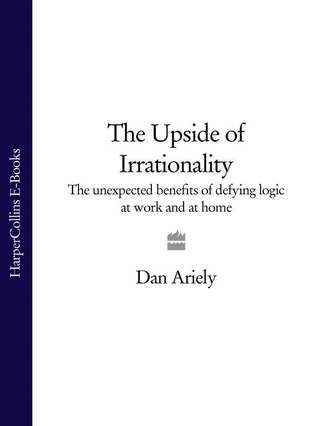
Полная версия
The Upside of Irrationality: The Unexpected Benefits of Defying Logic at Work and at Home
To introduce loss aversion into our experiment, we prepaid participants in the small-bonus condition 24 rupees (6 times 4). Participants in the medium-bonus condition received 240 rupees (6 times 40), and participants in the very-large-bonus condition were prepaid 2,400 rupees (6 times 400). We told them that if they got to the very good level of performance, we would let them keep all of the payment for that game; if they got to the good level of performance, we would take back half of the amount per game; and if they did not even reach the good level of performance, we would take back the entire amount per game. We thought that our participants would feel more motivated to avoid losing the money than they would by just trying to earn it.
Ramesh carried out this version of the experiment in a different village with two participants. But he went no further because this approach presented us with a unique experimental challenge. When the first participant stepped into the community center, we gave him all the money he could conceivably make from the experiment—2,400 rupees, equivalent to about five months’ salary—in advance. He didn’t manage to do any task well, and, unfortunately for him, he had to return all the money. At that point we looked forward to seeing if the rest of the participants would exhibit a similar pattern. Lo and behold, the next participant couldn’t manage any of the tasks either. The poor fellow was so nervous that he shook the whole time and couldn’t concentrate. But this guy did not play according to our rules, and at the end of the session he ran away with all of our money. Ramesh didn’t have the heart to chase him. After all, who could blame the poor guy? This incident made us realize that including loss aversion might not work in this experiment, so we switched to paying people at the end.
There was another reason why we wanted to prepay participants: we wanted to try to capture the psychological reality of bonuses in the marketplace. We thought that paying up front was analogous to the way many professionals think about their expected bonuses every year. They come to think of the bonuses as largely given and as a standard part of their compensation. They often even make plans for spending it. Perhaps they eye a new house with a mortgage that would otherwise be out of reach or plan a trip around the world. Once they start making such plans, I suspect that they might be in the same loss aversion mind-set as the prepaid participants.
Thinking versus Doing
We were certain that there would be some limits to the negative effect of high reward on performance—after all, it seemed unlikely that a significant bonus would reduce performance in all situations. And it seemed natural to expect that one limiting factor (what psychologists call a “moderator”) would depend on the level of mental effort the task required. The more cognitive skill involved, we thought, the more likely that very high incentives would backfire. We also thought that higher rewards would more likely lead to higher performance when it came to noncognitive, mechanical tasks. For example, what if I were to pay you for every time you jump in the next twenty-four hours? Wouldn’t you jump a lot, and wouldn’t you jump more if the payment were higher? Would you reduce your jumping speed or stop while you still had the ability to keep going if the amount were very large? Unlikely. In cases where the tasks are very simple and mechanical, it’s hard to imagine that very high motivation would backfire.
This reasoning is why we included a wide range of tasks in the experiment and why we were somewhat surprised that the very high reward level resulted in lower performance on all our tasks. We had certainly expected this to be the case for the more cognitive tasks such as the Simon and Recall Last Three Numbers games, but we hadn’t expected the effect to be just as pronounced for the tasks that were more mechanical in nature, such as the Dart Ball and Roll-up games. How could this be? One possibility was that our intuition about mechanical tasks was wrong and that, even for those kinds of tasks, very high incentives can be counterproductive. Another possibility was that the tasks that we considered as having a low cognitive component (Dart Ball and Roll-up) still required some mental skill and we needed to include purely mechanical tasks in the experiment.
With these questions in mind, we next set out to see what would happen if we took one task that required some cognitive skills (in the form of simple math problems) and compared it to a task that was based on pure effort (quickly clicking on two keyboard keys). Working with MIT students, we wanted to examine the relationship between bonus size and performance when the task was purely mechanical, as opposed to a task that required some mental ability. Given my limited research budget, we could not offer the students the same range of bonuses we had offered in India. So we waited until the end of the semester, when the students were relatively broke, and offered them a bonus of $660—enough money to host a few parties—for a task that would take about twenty minutes.
Our experimental design had four parts, and each participant took part in all four of them (this setup is what social scientists call a within-participant design). We asked the students to perform the cognitive task (simple math problems) twice: once with the promise of a low bonus and once with the promise of a high bonus. We also asked them to perform the mechanical task (clicking on a keyboard) twice: once with the promise of a low bonus and once with the promise of a high bonus.
What did this experiment teach us? As you might expect, we saw a difference between the effects of large incentives on the two types of tasks. When the job at hand involved only clicking two keys on a keyboard, higher bonuses led to higher performance. However, once the task required even some rudimentary cognitive skills (in the form of simple math problems), the higher incentives led to a negative effect on performance, just as we had seen in the experiment in India.
The conclusion was clear: paying people high bonuses can result in high performance when it comes to simple mechanical tasks, but the opposite can happen when you ask them to use their brains—which is usually what companies try to do when they pay executives very high bonuses. If senior vice presidents were paid to lay bricks, motivating them through high bonuses would make sense. But people who receive bonus-based incentives for thinking about mergers and acquisitions or coming up with complicated financial instruments could be far less effective than we tend to think—and there may even be negative consequences to really large bonuses.
To summarize, using money to motivate people can be a double-edged sword. For tasks that require cognitive ability, low to moderate performance-based incentives can help. But when the incentive level is very high, it can command too much attention and thereby distract the person’s mind with thoughts about the reward. This can create stress and ultimately reduce the level of performance.
AT THIS POINT, a rational economist might argue that the experimental results don’t really apply to executive compensation. He might say something like “Well, in the real world, overpaying would never be an issue because employers and compensation boards would take lowered performance into account and never offer bonuses that could make motivation inefficient. After all,” the rational economist might claim, “employers are perfectly rational. They know which incentives help employees perform better and which incentives don’t.”*
This is a perfectly reasonable argument. Indeed, it is possible that people intuitively understand the negative consequence of high bonuses and would therefore never offer them. On the other hand, much like many of our other irrationalities, it is also possible that we don’t exactly understand how different forces, including financial bonuses, influence us.
In order to try to find out what intuitions people have about high bonuses, we described the India experiment in detail to a large group of MBA students at Stanford University and asked them to predict the performance in the small-, medium-, and very-large-bonus conditions. Without knowing our results, our “postdictors” (that is, predictors after the fact) expected that the level of performance would increase with the level of payment—mispredicting the effects of the very high bonuses on performance.
These results suggested that the negative effect of high bonuses is not something that people naturally intuit. It also suggests that compensation is an area in which we need to employ stringent empirical investigation, rather than rely on intuitive reasoning. But would companies and boards of directors abandon their own intuitions when it comes to setting salaries and use empirical data instead? I doubt it. In fact, whenever I have a chance to present some of our findings to high-ranking executives, I am continually surprised by how little they know or think about the efficacy of their compensation schemes and how little interest they have in figuring out how to improve them.*
What about Those “Special People”?
A few years ago, before the financial crisis of 2008, I was invited to give a talk to a select group of bankers. The meeting took place in a well-appointed conference room at a large investment company’s office in New York City. The food and wine were delicious and the views from the windows spectacular. I told the audience about different projects I was working on, including the experiments on high bonuses in India and MIT. They all nodded their heads in agreement with the theory that high bonuses might backfire—until I suggested that the same psychological effects might also apply to the people in the room. They were clearly offended by the suggestion. The idea that their bonuses could negatively influence their work performance was preposterous, they claimed.
I tried another approach and asked for a volunteer from the audience to describe how the work atmosphere at his firm changes at the end of the year. “During November and December,” the fellow said, “very little work gets done. People mostly think about their bonuses and about what they will be able to afford.” In response, I asked the audience to try on the idea that the focus on their upcoming bonuses might have a negative effect on their performance, but they refused to see my point. Maybe it was the alcohol, but I suspect that those folks simply didn’t want to acknowledge the possibility that their bonuses were vastly oversized. (As the prolific author and journalist Upton Sinclair once noted, “It is difficult to get a man to understand something when his salary depends upon his not understanding it.”)
Somewhat unsurprisingly, when presented with the results of these experiments, the bankers also maintained that they were, apparently, superspecial individuals; unlike most people, they insisted, they work better under stress. It didn’t seem to me that they were really so different from other people, but I conceded that perhaps they were right. I invited them to come to the lab so that we could run an experiment to find out for sure. But, given how busy bankers are and the size of their paychecks, it was impossible to tempt them to take part in our experiments or to offer them a bonus that would have been large enough to be meaningful for them.
Without the ability to test bankers, Racheli Barkan (a professor at Ben-Gurion University in Israel) and I looked for another source of data that could help us understand how highly paid, highly specialized professionals perform under great pressure. I know nothing about basketball, but Racheli is an expert, and she suggested that we look at clutch players—the basketball heroes who sink a basket just as the buzzer sounds. Clutch players are paid much more than other players, and are presumed to perform especially brilliantly during the last few minutes or seconds of a game, when stress and pressure are highest.
With the help of Duke University men’s basketball Coach Mike Krzyzewski (“Coach K”), we got a group of professional coaches to identify clutch players in the NBA (the coaches agreed, to a large extent, about who is and who is not a clutch player). Next, we watched videos of the twenty most crucial games for each clutch player in an entire NBA season (by most crucial, we meant that the score difference at the end of the game did not exceed three points). For each of those games, we measured how many points the clutch players had shot in the last five minutes of the first half of each game, when pressure was relatively low. Then we compared that number to the number of points scored during the last five minutes of the game, when the outcome was hanging by a thread and stress was at its peak. We also noted the same measures for all the other “nonclutch” players who were playing in the same games.
We found that the nonclutch players scored more or less the same in the low-stress and high-stress moments, whereas there was actually a substantial improvement for clutch players during the last five minutes of the games. So far it looked good for the clutch players and, by analogy, the bankers, as it seemed that some highly qualified people could, in fact, perform better under pressure.
But—and I’m sure you expected a “but”—there are two ways to gain more points in the last five minutes of the game. An NBA clutch player can either improve his percentage success (which would indicate a sharpening of performance) or shoot more often with the same percentage (which suggests no improvement in skill but rather a change in the number of attempts). So we looked separately at whether the clutch players actually shot better or just more often. As it turned out, the clutch players did not improve their skill; they just tried many more times. Their field goal percentage did not increase in the last five minutes (meaning that their shots were no more accurate); neither was it the case that nonclutch players got worse.
At this point you probably think that clutch players are guarded more heavily during the end of the game and this is why they don’t show the expected increase in performance. To see if this were indeed the case, we counted how many times they were fouled and also looked at their free throws. We found the same pattern: the heavily guarded clutch players were fouled more and got to shoot from the free-throw line more frequently, but their scoring percentage was unchanged. Certainly, clutch players are very good players, but our analysis showed that, contrary to common belief, their performance doesn’t improve in the last, most important part of the game.
Obviously, NBA players are not bankers. The NBA is much more selective than the financial industry; very few people are sufficiently skilled to play professional basketball, while many, many people work as professional bankers. As we’ve seen, it’s also easier to get positive returns from high incentives when we’re talking about physical rather than cognitive skills. NBA players use both, but playing basketball is more of a physical than a mental activity (at least relative to banking). So it would be far more challenging for the bankers to demonstrate “clutch” abilities when the task is less physical and demands more gray matter. Also, since the basketball players don’t actually improve under pressure, it’s even more unlikely that bankers would be able to perform to a higher degree when they are under the gun.
A CALL FOR LOWER BONUSES
One congressman publicly questioned the ethics of very large bonuses when he addressed the annual awards dinner of the trade newspaper American Banker at the New York Palace Hotel in 2004. Representative Barney Frank of Massachusetts, who, at the time, was the senior Democrat on the House Financial Services Committee (he’s currently the chairman) and hardly your run-of-the-mill, flattering “Thank you all so much for inviting me” speaker, began with a question: “At the level of pay that those of you who run banks get, why the hell do you need bonuses to do the right thing?” He was answered by an abyss of silence. So he went on: “Do we really have to bribe you to do your jobs? I don’t get it. Think what you are telling the average worker—that you, who are the most important people in the system and at the top, your salary isn’t enough, you need to be given an extra incentive to do your jobs right.”
As you may have guessed, two things happened, or rather did not happen, after this speech. First, no one answered his questions; second, no standing ovation was given. But Frank’s point is important. After all, bonuses are paid with shareholders’ money, and the effectiveness of those expensive payment schemes is not all that clear.
Public Speaking 101
The truth is that all of us, at various times, struggle and even fail when we perform tasks that matter to us the most. Consider your performance on standardized tests such as the SAT. What was the difference between your score on the practice tests and your score on the real SAT? If you are like most people, the result on your practice tests was most likely higher, suggesting that the pressure of wanting to perform well led you to a lower score.
The same principle applies to public speaking. When preparing to give a speech, most people do just fine when they practice their talk in the privacy of their offices. But when it’s time to stand up in front of a crowd, things don’t always go according to plan. The hypermotivation to impress others can cause us to stumble. It’s no coincidence that glossophobia (the fear of public speaking) is right up there with arachnophobia (fear of spiders) on the scary scale.
As a professor, I have had a lot of personal experience with this particular form of overmotivation. Early in my academic career, public speaking was difficult for me. During one early presentation at a professional conference in front of many of my professors, I shook so badly that every time I used the laser pointer to emphasize a particular line on a projected slide, it raced all over the large screen and created a very interesting light show. Of course, that just made the problem worse and, as a result, I learned to make do without a laser pointer. Over time and with a lot of experience, I became better at public speaking, and my performance doesn’t suffer as much these days.
Despite years of relatively problem-free public speaking, I recently had an experience where the social pressure was so high that I flubbed a talk at a large conference in front of many of my colleagues. During one session at a conference in Florida, three colleagues and I were going to present our recent work on adaptation, the process through which people become accustomed to new circumstances (you’ll read more about this phenomenon in chapter 6, “On Adaptation”). I had carried out some studies in this area, but instead of talking about my research findings, I planned to give a fifteen-minute talk about my personal experience in adapting to my physical injuries and present some of the lessons I had learned. I practiced this talk a few times, so I knew what I was going to say. Aside from the fact that the topic was more personal than is usual in an academic presentation, I did not feel that the talk was that much different from others I have given over the years. As it turned out, the plan did not match the reality in the slightest.
I started the lecture very calmly by describing my talk’s objective, but, to my horror, the moment I started describing my experience in the hospital, I teared up. Then I found myself unable to speak. Avoiding eye contact with the audience, I tried to compose myself as I walked from one side of the room to the other for a minute or so. I tried again but I could not talk. After some more pacing and another attempt to talk, I was still unable to talk without crying.
It was clear to me that the presence of the audience had amplified my emotional memory. So I decided to switch to an impersonal discussion of my research. That approach worked fine, and I finished my presentation. But it left me with a very strong impression about my own inability to predict the effects of my own emotions, when combined with stress, on my ability to perform.
WITH MY PUBLIC failure in mind, Nina, Uri, George, and I created yet another version of our experiments. This time, we wanted to see what would happen when we injected an element of social pressure into the experimental mix.
In each session of this experiment, we presented eight students at the University of Chicago with thirteen sets of three anagrams, and paid them for each of the anagrams they solved. As an example, try to rearrange the letters of the following meaningless words to form meaningful ones (do this before you look at the footnote*):
1. SUHOE
Your solution:
2. TAUDI
Your solution:
3. GANMAAR
Your solution:
In eight of the thirteen trials, participants solved their anagrams working alone in private cubicles. In the other five trials, they were instructed to stand up, walk to the front of the room, and try to solve the anagrams on a large blackboard in plain view of the other participants. In these public trials, performing well on the anagrams was more important, since the participants would not only receive the payment for their performance (as in the private trials) but would also stand to reap some social rewards in the form of the admiration of their peers (or be humiliated if they failed in front of everyone). Would they solve more anagrams in public—when their performance mattered more—or in private, when there was no social motivation to do well? As you’ve probably guessed, the participants solved about twice as many anagrams in private as in public.
THE PSYCHOANALYST AND concentration camp survivor Viktor Frankl described a related example of choking under social pressure. In Man’s Search for Meaning, Frankl wrote about a patient with a persistent stutter who, try as he might, could not rid himself of it. In fact, the only time the poor fellow had been free of his speech problem was once when he was twelve years old. In that instance, the conductor of a streetcar had caught the boy riding without a ticket. Hoping the conductor would pity him for his stutter and let him off, the boy tried to stutter—but since he did not have any incentive to speak without stuttering, he was unable to do it! In a related example, Frankl describes a patient with a fear of perspiring: “Whenever he expected an outbreak of perspiration, this anticipatory anxiety was enough to precipitate excessive sweating.” In other words, the patient’s high social motivation to be sweat-free ironically led to more perspiration or, in economic terms, to lower performance.
In case you’re wondering, choking under social pressure is not limited to humans. A variety of our animal friends have been put to similar tests, including no one’s favorite—the cockroach—who starred in one particularly interesting study. In 1969, Robert Zajonc, Alexander Heingartner, and Edward Herman wanted to compare the speed at which roaches would accomplish different tasks under two conditions. In one, they were alone and without any company. In the other, they had an audience in the form of a fellow roach. In the “social” case, the other roach watched the runner through a Plexiglas window that allowed the two creatures to see and smell each other but that did not allow any direct contact.
One task that the cockroaches performed was relatively easy: the roach had to run down a straight corridor. The other, more difficult task required the roach to navigate a somewhat complex maze. As you might expect (assuming you have expectations about roaches), the insects performed the simpler runway task much more quickly when another roach was observing them. The presence of another roach increased their motivation, and, as a consequence, they did better. However, in the more complex maze task, they struggled to navigate their way in the presence of an audience and did much worse than when they performed the same complex task alone. So much for the benefits of social pressure.










